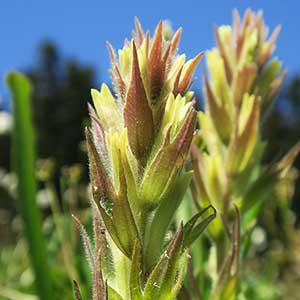Castilleja chromosa
Castilleja cryptantha
desert paintbrush
Mt. Rainier or obscure paintbrush, obscure Indian paintbrush, obscure paintbrush
several to many, ascending to erect, often grayish, unbranched, rarely branched, sometimes with short, leafy axillary branches, hairs spreading-erect, long, stiff, eglandular, sometimes also with shorter, stipitate-glandular ones.
few to several, erect or ascending, unbranched, hairs spreading, long, soft, eglandular, mixed with short stipitate-glandular ones.
gray-green, linear, lanceolate, or oblanceolate, sometimes broadly lanceolate, (1.5–)2.5–6(–7) cm, not fleshy, margins plane, involute, (0–)3–5(–7)-lobed, sometimes with secondary lobes, apex acuminate to obtuse;
lobes spreading, linear, apex acuminate.
green, often with brown or purple veins, narrowly to broadly lanceolate, 1.5–4 cm, not fleshy, margins plane, ± involute, 0–3-lobed, apex acute to acuminate;
lobes spreading-ascending, narrowly lanceolate, apex acute to ± obtuse.
2.5–15 (much longer in fruit) × 1.5–5.5 cm;
bracts proximally greenish to dull purplish, distally bright red to scarlet or orange-red, rarely yellowish to dull orange or pink, narrowly to broadly linear or lanceolate, narrowly ovate, or oblong-lanceolate, (0–)3–7-lobed, rarely with secondary lobes;
lobes spreading, linear to oblong, sometimes oblanceolate, often expanded near tip, long, proximal lobes arising below mid length, apex rounded or obtuse to sometimes acute.
(2.5–)3–6 × 1–2 cm; green to dull brown or dull reddish purple throughout, or proximally green to dull brown or dull reddish purple, distally yellow on apices, broadly lanceolate to ovate, (0–)3-lobed;
lobes ascending, narrowly lanceolate, long or short, arising near mid length, apex acute or acuminate.
straight or ± curved, 18–35(–40) mm;
tube 8–15 mm;
beak short- or long-exserted, adaxially green to yellow-green, (9–)10–18 mm;
abaxial lip deep green, reduced, thickened, included to exserted, 2–3 mm, ca. 20% as long as beak;
teeth incurved, deep green, 0.5–1 mm.
straight, 14–16 mm;
tube 11–14 mm;
whole corolla included within calyx;
beak adaxially pale yellow, 1–2 mm;
abaxial lip deep green, slightly inflated, 4–5 mm, 67% as long as beak;
teeth ascending, pale, 1.5–2 mm.
colored as bracts, sometimes with broad yellow band below colored lobe apices, (17–)20–27 mm;
abaxial clefts 4–10 mm, adaxial 6–12 mm, abaxial ca. 30% of calyx length, adaxial ca. 40% of calyx length, deeper than laterals, lateral 1–4 mm, ca. 15% of calyx length;
lobes oblong or ovate to narrowly triangular or lanceolate, apex obtuse to rounded.
proximally green or pale with green veins, lobes yellow, sometimes becoming deep red with age, 12–15 mm;
abaxial and adaxial clefts 3–7 mm, 25–50% of calyx length, deeper than laterals, lateral 1–3(–4) mm, 8–20% of calyx length;
lobes triangular, adaxial segments longer than abaxials, apex acute or obtuse.
= 24, 48.
= 24.
Castilleja chromosa
Castilleja cryptantha
Castilleja chromosa is sometimes confused with 3b. C. angustifolia var. dubia (see discussion there). Castilleja chromosa retains its distinctive morphology across its wide range and is a characteristic species of much of the southwestern United States. Where it overlaps with C. angustifolia, the two are distinguished by inflorescence color and width and by the lengths of the calyx, corolla, and corolla beak. In the broad region of their sympatry, there is little evidence of intergradation, except in a few sites in Elko County, Nevada, and in southern Wyoming. Throughout southern Idaho and northeastern Nevada the range of the two overlap with little or no intergradation. At high elevations in Montrose County, Colorado, C. chromosa has narrower leaves and a longer and silkier pubescence, especially in the inflorescence. Apparent hybrids between C. chromosa and C. flava var. rustica are known from Custer County, Idaho, and hybrids with C. linariifolia are known from Montrose County, Colorado.
(Discussion copyrighted by Flora of North America; reprinted with permission.)
Castilleja cryptantha is endemic to the vicinity of Mt. Rainier in the Cascade Range, with most populations found within Mt. Rainier National Park. Unlike most species of Castilleja, it is apparently self-pollinating (W. J. Duffield 1972); the small flowers are entirely enclosed within the yellowish calyces, which tend to grow deep reddish as they age. The purplish brown bracts are also unusual in the genus.
(Discussion copyrighted by Flora of North America; reprinted with permission.)


